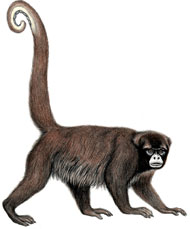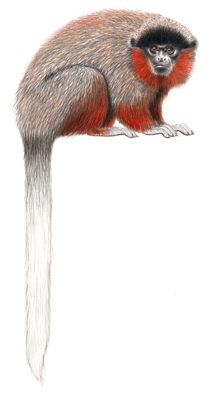
October 30, 2007

Drawings of the yellow-tailed woolly monkey (Oreonax flavicauda) by artist Stephen Nash were used in Peru to rediscover the primate.
The use of identikit illustrations in support of the cryptozoology method is demonstrated often. The objective is to discovery what is already ethnoknown, in terms of local wildlife. Drawings from scratch, under the direction of locals, are a source of primary information. But oftentimes, identikit materials are used in the field for gathering and fine-tuning visual information.

Sometimes, if available, a photograph shown to local residents and indigenous peoples is successful in gathering more data on new animals. This is what worked best when going after the second cryptozoological finding of a complete body of a coelacanth in 1952. Posters (as shown) were distributed throughout southern and western coastal Africa, picturing the photograph of the 1938 specimen. It was a poster that resulted in the intact rediscovery of the second coelacanth.
But what if there are no photographs of the species? The next best choices are good drawings of the reported animals (cryptids), of course.
Tom Slick used sketches of primates and prehistoric humans for matching with Yeti types, when interviewing Sherpas and Nepalese informants. Roy Mackal showed drawings to find out what descriptions the Congolese Pygmies had for Mokele-Mbembe. Scott Norman and John Kirk in the Cameroons and Bobbie Short in the Philippines employed illustrations from a cryptozoological field guide, when talking to locals about identifying their location’s unknown hairy hominoids.

The yellow-tailed woolly monkey (Oreonax flavicauda) – above – by artist Stephen Nash.
The rediscovery of the yellow-tailed woolly monkey, while little mentioned in the cryptozoology literature, used a similar cryptozoology method. Today, it is known to occur only in a few locations in the montane cloud forests of Eastern Peru.
Alexander von Humboldt was the first Western scientist to observe the yellow-tailed woolly monkey, in 1802. Other than 5 specimens that were collected in 1925 and 1926, nothing further was reported about this monkey until it was observed by an outside expedition in 1974.
Writing in The New York Times on October 30, 2007, reporter Andrew C. Revkin devoted a column to “The Art of Primate Conservation.”
Revlon gives an excellent example that is reflective of the cryptozoology method, which depends on the ethnoknown value of more information from locals on their hidden animals:
An American biologist, Russell Mittermeier, had the idea of using [artist Stephen] Nash’s precise drawings as a conservation tool. Mr. Nash began drawing for Conservation International a quarter century ago and is still at it now. Dr. Mittermeier is now president of the group.
One of Mr. Nash’s early efforts, drawings of the yellow-tailed woolly monkey of Peru, helped bring that species back out of presumed extinction in the early 1980s. “It existed only as skins in museums in Peru,” [Mr. Nash] said. “Then one day Dr. Mittermeier and his Peruvian colleagues were on an expedition in an area where they thought the animal might have hung on and they found a Peruvian using the skin of one as a sort of saddle blanket. It was a relatively recently obtained skin so they knew that the animals must be in the area.
“He requested I produce a drawing of the animal,’’ Mr. Nash said. “We produced posters and T-shirts, and local people, including former hunters, gave lectures to school children and such and all of a sudden populations of these animals were found. They’re from high in the cloud forests that are recognized as important for the watershed. If the local people cut own the forest and render extinct the monkey they lose the reliable water supply for their rice further down the mountain. So it all ties into benefits for the local population as well. It’s common sense that what’s good for the monkey is good for the humans too.” – Andrew C. Revkin

The Callicebus stephennashi, or Stephen Nash’s titi monkey, was named after Mr. Nash, in 2002, after its discovery in Brazil. In 1963 the Titi monkeys comprised three known species, but when Stephen Nash’s titi monkey was announced in 2002, the number had risen to 28. It was also noted that since 1980, 38 species of monkeys have been discovered worldwide, 13 of them in Brazil. Russell Mittermeier’s Conservation International was responsible for many of the new discoveries.
For a slide show of more of Mr. Nash’s beautiful drawings, see here.
About Loren Coleman
Loren Coleman is one of the world’s leading cryptozoologists, some say “the” leading living cryptozoologist. Certainly, he is acknowledged as the current living American researcher and writer who has most popularized cryptozoology in the late 20th and early 21st centuries.
Starting his fieldwork and investigations in 1960, after traveling and trekking extensively in pursuit of cryptozoological mysteries, Coleman began writing to share his experiences in 1969. An honorary member of Ivan T. Sanderson’s Society for the Investigation of the Unexplained in the 1970s, Coleman has been bestowed with similar honorary memberships of the North Idaho College Cryptozoology Club in 1983, and in subsequent years, that of the British Columbia Scientific Cryptozoology Club, CryptoSafari International, and other international organizations. He was also a Life Member and Benefactor of the International Society of Cryptozoology (now-defunct).
Loren Coleman’s daily blog, as a member of the Cryptomundo Team, served as an ongoing avenue of communication for the ever-growing body of cryptozoo news from 2005 through 2013. He returned as an infrequent contributor beginning Halloween week of 2015.
Coleman is the founder in 2003, and current director of the International Cryptozoology Museum in Portland, Maine.
Filed under Abominable Snowman, Breaking News, Cryptomundo Exclusive, Cryptotourism, CryptoZoo News, Cryptozoologists, Cryptozoology, Evidence, Expedition Reports, Eyewitness Accounts, Folklore, Forensic Science, Living Dinosaurs, Media Appearances, Men in Cryptozoology, New Species, Photos, Pop Culture, Yeti